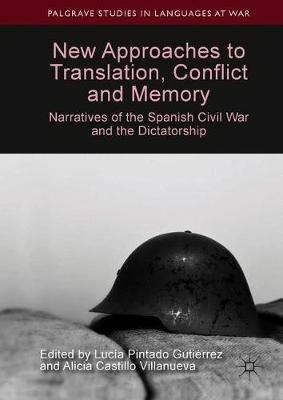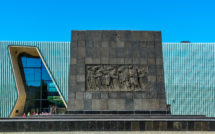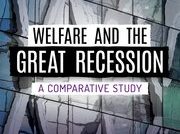
New Approaches to Translation, Conflict and Memory. Narratives of the Spanish Civil War and the Dictatorship edited by Lucía Pintado Gutiérrez and Alicia Castillo Villanueva

In the last fifteen years, Spaniards have seen a significant increase in the amount of news, films, literary works, historical evaluations, and debates in their country surrounding the memory of the Civil War (1936-1939) and Franco’s dictatorship (1939-1975). The current socialist government’s initiative to exhume Franco’s body from the “Valley of the Fallen”—a national monument notoriously built by Republican political prisoners and a major symbol of the dictatorship’s political repression—is evidence of how a national trend to memorialize those traumatic episodes of the past century has gained momentum. It was precisely José Luis Rodríguez Zapatero’s socialist government that enacted the so-called “Historical memory Law” (2007) with the aim of contributing to the recognition of the victims of the war and officially condemning Franco’s regime, while financing the tracing and exhumation of the many mass graves that remain undocumented. This law was instrumental in reigniting the debate around the Civil War and the dictatorship after a tacit “pact of forgetting” had omitted the Franco regime from national politics. It is unclear whether the growing number of literary works and films in the last almost two decades which deal with Spain’s traumatic past, has been a consequence or a precipitating factor of this political debate.
This new social presence of historical memory provides the framework for the ten engaging contributions to New Approaches to Translation. This edited volume is published in the series “Languages at War,” which focuses on the study of the role of language in situations of war and conflict resolution. The editors, Lucía Pintado Villanueva and Alicia Castillo Gutiérrez, adopt a wide, interdisciplinary approach—covering translation studies, memory studies, history, cultural studies, sociolinguistics, and intercultural communications—to examine the role of translation in dialogue with memory and conflict studies. They also put forward their “ethical commitment to justice, truth, and moral reparation for those who were erased from the official history and relegated to oblivion” (4). The studies of New Approaches to Translation engage with this commitment using a variety of topics and approaches. Consequently, New Approaches to Translation stems from a broad understanding of the term “translation,” in tune with the most innovative and recent approaches in Translation Studies: beyond “interlingual translation,” “translation” covers non-linguistic intercultural contents as well as the transmission of historical memory between different nations and traditions. The main thematic axes that run through the different chapters are therefore dedicated to clarifying the relations between translation, memory, and power: how translation can be conceived as a form of culturally reinterpreting a war period (Part II); how political power influences, determines and constrains the work of translators and interpreters in the context of a civil war or a dictatorship (Parts III and IV); and how historical memory gets translated from generation to generation, from culture to culture, opening up the way to a new transnational experience of collective memory that can help societies connect more deeply and respectfully with their own legacy (Part V).
From a general perspective, the authors illustrate how the act of translating was, on many occasions, at the center of political resistance both during the Spanish Civil War and in the long dictatorship that ensued. Chapters in Part IV, dedicated to studying the effects of censorship upon several translations from English to Spanish carried out during Franco’s dictatorship, are especially skillful in combining a detailed analysis of sources (the censors’ files of the General Archive of Administration, kept in the city of Alcalá de Henares) with a sociological focus. This approach helps to explain the correspondence between the changes and omissions imposed by the censorship and Francoist ideology as displayed in textbooks and propaganda materials on the ideal society the regime pursued. As a result, these chapters display a valuable description of the mechanisms of political repression and resistance, which contextualize anecdotal evidence into the ideological apparatus of Franco’s dictatorship. At the same time, especially through Pilar Godayol’s chapter on the troubling process of the translation and publication of Mary McCarthy’s feminist novels in Spain, we also become fully aware of how translating and publishing certain authors was, in essence, an act of political resistance during the regime. The tenacity of Spanish translators and editors in their resolve to publish McCarthy’s novels, despite the constant pitfalls of censorship, serves as an example of how translation contributed to creating a democratic culture.
Translation, understood as rewriting and transmission of ideologies, is another guiding line across most of the essays in New Approaches, whereby the authors manage to illuminate complex political situations through the analysis of both textual and testimonial evidence. This is the case in several chapters in Parts II, III, and V, which introduce a particularly interesting focus on the translation/mistranslation of ideological content across different national cultures. Patricia San José and Andrew Samuel Walsh’s essays on Langston Hughes and his experience in Spain during the Spanish Civil War, and Marcos Rodríguez Espinosa’s chapter on the activities of the language interpreters who worked for the International Brigades (1937-1938), illustrate the intricate battleground the brigade members had to face, as well as their cultural misreadings. The distortions that might appear when studying a foreign nation’s past are also contemplated from a contemporary perspective in Part V. Two chapters deal with the memory of the Spanish Civil War as displayed in recent literature, and with the translation of TV fiction subtitles from Spanish to Portuguese and English. The authors rely on the concept of “transnational memory” to find analogies between national histories (Espada Vieira) as well as to illustrate the way in which international television audiences determine the need to mistranslate history either by simplifying, or blurring all politically inconvenient references (Kietrys). These analyses are particularly pertinent in the context of national branding and media globalization, and underline the ethical and political responsibility that translation entails.
Memory becomes more prevalent as a topic in the last part of the book through two main theoretical frameworks: Marianne Hirsh’s notion of “post-memory” –the memory inherited from the survivors of a collective trauma– and the Derridian notion of “hauntology,” understood as the practice of revealing how the past pervades the present through the memory of long-gone generations. Translation between national collective memories is also extended to the field of poetry in Cáceres Casillas’ chapter which analyzes Félix Grande’s La cabellera de la Shoa (The Hair of the Shoa), the only Spanish long poem dedicated to the Jewish Holocaust. This particular essay is an excellent example of the enlargement of the notion of translation that underlays this volume: translation between languages and cultures, but also between the memory of different generations, requires an ethical commitment to give testimony to a past that needs to be preserved from oblivion.
Overall, New Approaches to Translation provides important insights on the historical memory of Spain through the broad notion of translation. The strength of the book does not lie upon the presentation of new theoretical perspectives on the interplay between memory and Translation Studies, but upon the discernment with which the authors apply innovative concepts and methodologies already established to produce useful, clarifying contributions for those interested in both historical memory and translation. New Approaches to Translation demonstrates that the study of translation provides valuable tools for deeper understanding of the historical and political aspects that construct a country’s collective memory and its international image.
José Luis Fernández Castillo (La Trobe University, Australia) publishes on twentieth-century and Contemporary Latin American and Spanish literature, with a focus on comparative literature and the interplay of poetry with religion and philosophy. His monograph Octavio Paz y las transformaciones de lo divino (Buenos Aires: Biblos) was published in 2016.
New Approaches to Translation, Conflict and Memory. Narratives of the Spanish Civil War and the Dictatorship
Edited by Lucía Pintado Gutiérrez and Alicia Castillo Villanueva
Publisher: Palgrave Macmillan
Hardcover / 234 pages / 2019
ISBN: 9783030006976
Published on January 16, 2020.




